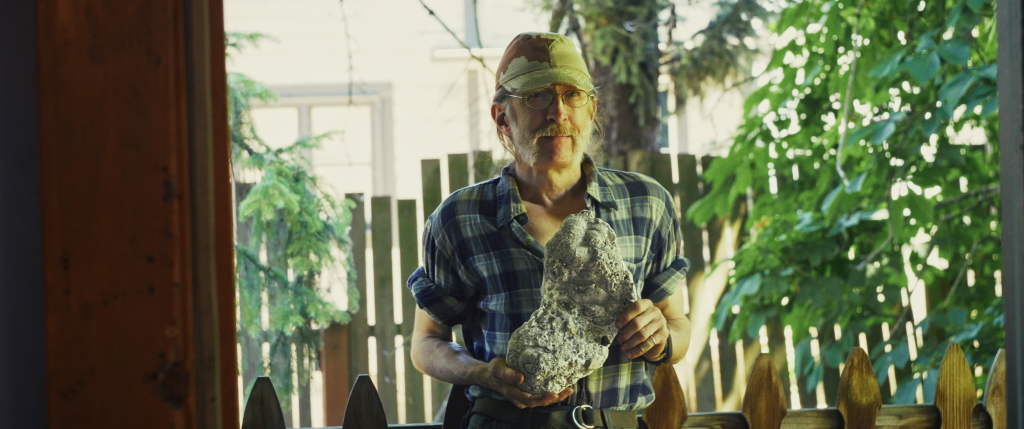Reviews
‘MEAT’ (2025) Review: Slow-Cooked, and Worth the Wait

It’s been a hot minute since my interview with director Roger Conners talking about his feature film Meat. Armed with three thousand metallic spikes and a burning desire for revenge, the instantly iconic design of its killer stood out as the horror villain I was most excited to see in 2023. Unfortunately, like most horror projects I get excited for, it got caught in traffic. But after two years of waiting for Meat to escape crowdfunding and post-production purgatory, The Stud has finally arrived.
A Story of Revenge and Redemption
After four long years of wrongful imprisonment, Noah (Cody Steele) is back. Taking the fall for his friends and being charged with the manslaughter of a young gay man named Paul, he returns to his hometown in hopes of rebuilding his life. Vilified by the media and locals, it’s a slow climb back to normalcy that at points feels impossible.
But when Noah is reunited with those so-called friends, the predatory it-boy Dante (Anthony Covatta) and his gang of lackeys, it’s not long before things go sideways. A masked serial killer has come knocking to collect on the people that actually killed Paul. Coated in silver and black leather, The Stud is out for blood, and no one is safe.
Meat: Exploring Queer Culture in Horror
One of the strongest aspects of Meat is the approach it takes to depicting a cultural space, the queer club scene, that is often sanded down for consumption. In almost every piece of media they’re depicted in, they’re sanitized to the point of being unrecognizably squeaky clean or maligned as one-dimensional hell holes. Meat instead takes a look at the people in these spaces, good, bad, and ugly, and examines them for a good long while before the film runs headfirst into the sleazy slasher territory its second and third acts inhabit.

Addressing Abuse in Safe Spaces
Meat is a film that confronts a harsh reality: in places where people are supposed to feel free to be themselves, and where a lot of queer people go to begin their journey of expression and self-understanding, there are inevitably going to be people who want to take advantage of that. Meat offers a measure of catharsis for those who have had to witness awful people infest their third spaces, with The Stud annihilating those who try to steal that space away from others.
An Uncompromising Story With an Uncompromising Vision
Meat is, as to be expected from most pieces of queer media, an uncompromising slasher.
Roger Conners’ vision here is the kind of counterculture cattle prod that will ruffle feathers. Especially among the people who can’t tolerate that it’s unabashedly a film made by, with, and for a queer audience.
It’s clear down to every shot, scene, and editing choice that Conners has gone all in on crafting the film from frame to frame. Sometimes that presentation rubs up against my personal preferences, with editing choices, and some minor visual kinks being my main gripes. I bring these up not to nitpick at the film, but to emphasize that the blemishes that would usually bother me much more with the indie horror films I watch are peripheral problems here.
Themes of Anger, Love, and Catharsis
It’s what Meat is trying to say that interests me more. Meat is designed to buck up against most sensibilities to tell a raw story with some especially difficult subject matter. It’s a story about abuse, the kind that happens on a community scale. It’s about anger first and love second; it speaks on indignation and affection for people coexisting inside of someone, and the conflicting feelings that arise from traumatic situations. In that department, Meat tells an excellent story centered around its main character Noah.
Steele’s performance as the burnt offering that saved the friend group is teeming with a good amount of believable resentment. I like how angsty his character becomes, and how he conveys that experience, as it really fits the film’s themes well.

Grimy, Gory, and Hard Not to Have Fun With
As Conners himself said, this is a film about mean gays doing shitty things and getting their deserved comeuppance. And that comeuppance can only come in the form of some very brutal kills. In how the film concocts its deaths, Meat’s recipe is simple: The Stud is channeling part Ghostface, part The Prowler, and just a dash of Frank from Maniac. He’s mean, lean, and no nonsense. He’s here to get the job done.
The practical effects here as The Stud cuts down his targets is the most obvious highlight, with some genuinely surprising prosthetics and makeup coming from a production this small. The first kill in the film especially sets the tone right, letting you know that no punches will be pulled. It’s not on Terrifier levels of grotesquery, but it’s enough to make you wince.
A Cast That Shines With Charismatic Villains
Despite the majority of the characters in this movie being awful people, the cast is very charming, in a way that made me conflicted; I’m supposed to hate these characters, and the film is clear about that, but some of the actors are too fun on screen to dislike and cause some mental dissonance. A standout performance comes from Matt Kane, playing the meathead himbo Vinny, truly inhabiting the role perfectly. There is also a near perfect death scene in the film, that I won’t spoil, which results from the culmination of a very camp chase sequence that feels ripped straight from the dailies of an 80’s Corman horror film.
While some of the cinematography is rough around the edges, the amount of genuine enthusiasm you feel throughout it and the topics that Meat tackles make it one of the most unique horror films you’re going to watch all year. And if the story doesn’t interest you and you’re really just here for carnage, you’re at the very least bound to have fun with the more traditional slasher fare it offers. Meat is a movie that’s been cooking low and slow for a while, and I feel I can confidently say the wait was worth it. Don’t count this one out just because it took some time getting here.
Reviews
‘Frankenstein’ Review: Guillermo Del Toro Is Off to the Races

Those expecting Guillermo Del Toro’s Frankenstein to be similar to the book, or to any other adaptation, are in for something else. A longtime enjoyer of the creature’s story, Del Toro instead draws from many places: the novel, James Whale’s culturally defining 1931 film, the Kenneth Branagh version, there are even hints from Terence Fisher’s Curse of Frankenstein, and if the set design and costuming are to be believed, there are trace elements of the National Theatre production too.
The formulation to breathe life into this amalgam is a sort of storm cloud of cultural memory and personal desire for Del Toro. This is about crafting his Frankenstein: the one he wanted to see since he was young, the vision he wanted to stitch together. What results is an experience that is more colorful and kinetic and well-loved by its creator than any Frankenstein we’ve had yet, but what it leaves behind is much of its gothic heart. Quiet darkness, looming dread, poetry, and romance are set aside as what has been sold as “the definitive retelling” goes off to the races. It’s a fast-paced ride through a world of mad science, and you’re on it.
Victor Frankenstein’s Ambition and Tragedy
A tale as old as time, with some changes: the morbid talents and untamed hubris of Victor Frankenstein (Oscar Isaac) guide him to challenge death itself. Spurred by a wealthy investor named Henrich Harlander, and a desire for Harlander’s niece Elizabeth (Mia Goth), Victor uses dead flesh and voltaic vigor to bring a creature to life. His attempts to rear it, however, go horribly wrong, setting the two on a bloody collision course as the definitions of man and monster become blurred.
Guillermo Del Toro’s Frankenstein is more Hellboy in its presentation than it is Crimson Peak; it’s honestly more similar to Coppola’s Dracula than either of them. The film is barely done with its opening when it starts with a loud sequence of the monster attacking Walton’s ship on the ice. Flinging crew members about and walking against volleys of gunfire, he is a monstrosity by no other name. The Creature (Jacob Elordi) cries out in guttural screams, part animal and part man, as it calls for its creator to be returned to him. While visually impressive (and it remains visually impressive throughout, believe me), this appropriately bombastic hook foreshadows a problem with tone and tempo.
A Monster That Moves Too Fast
The pace overall is far too fast for its first half, even with its heavy two-and-a-half-hour runtime. It’s also a far cry from the brooding nature the story usually takes. A scene where Victor demonstrates rudimentary reanimation to his peers and a council of judges is rapid, where it should be agonizingly slow. There’s horror and an instability in Victor to be emphasized in that moment, but the grotesque sight is an oddly triumphant one instead. Most do not revile his experiments; in fact he’s taken quite seriously.
Many scenes like this create a tonal problem that makes Victor’s tale lean more toward melodrama than toward philosophical or emotional aspects; he is blatantly wild and free, in a way that is respected rather than pitied. There are opportunities to stop, breathe in the Victorian roses and the smell of death, to get really dour, but it’s neglected until the film’s second half.
Isaac’s and Goth’s performances are overwrought at points, feeling more like pantomimes of Byronic characters. I’m not entirely convinced it has more to do with them than with the script they’re given. Like Victor working with the parts of inmates and dead soldiers, even the best of actors with the best of on-screen chemistry are forced to make do. The dialogue has incredibly high highs (especially in its final moments), but when it has lows, how low they are; a character outright stating that “Victor is the real monster” adage to his face was an ocean floor piece of writing if there ever was one.
Isaac, Goth, and Elordi Bring Life to the Dead
Jacob Elordi’s work here, however, is blameless. Though Elordi’s physical performance as the creature will surely win praise, his time speaking is the true highlight. It’s almost certainly a definitive portrayal of the character; his voice for Victor’s creation is haunted with scorn and solitude, the same way his flesh is haunted by the marks of his creator’s handiwork. It agonizes me to see so little of the books’ most iconic lines used wholesale here, because they would be absolutely perfect coming from Elordi. Still, he has incredible chemistry with both Isaac and Goth, and for as brief as their time together is, he radiates pure force.
Frankenstein Is a Masterclass in Mise-En-Scène
Despite its pacing and tone issues, one can’t help but appreciate the truly masterful craftsmanship Del Toro has managed to pack into the screen. Every millimeter of the sets is carved to specification, filled with personality through to the shadows. Every piece of brick, hint of frost, stain of blood, and curve of the vine is painstakingly and surgically placed to create one of the most wonderful and spellbinding sets you’ve seen—and then it keeps presenting you with new environments like that, over, and over.
At the very least, Del Toro’s Frankenstein is a masterpiece of mise-en-scène down to the minutest of details, and that makes it endlessly rewatchable for aesthetic purposes. This isn’t even getting into the effervescent lighting, or how returning collaborator Kate Hawley has outdone herself again with the costuming. Guillermo Del Toro tackling the king of gothic horror stories, a story written by the mother of all science fiction, inevitably set a high bar for him to clear. And while it’s not a pitch perfect rendering of Mary Shelley’s slow moving and Shakespearean epistolary, it is still one of the best-looking movies you will see all year.
Perhaps for us, it’s at the cost of adapting the straightforward, dark story we know into something more operatic. It sings the tale like a soprano rather than reciting it like humble prose, and it doesn’t always sing well. But for Del Toro, the epic scale and voice of this adaptation is the wage expected for making the movie he’s always dreamed of. Even with its problems, it’s well worth it to see a visionary director at work on a story they love.
Reviews
‘The Siege of Ape Canyon’ Review: Bigfoot Comes Home

In my home, films like Night of the Demon and Abominable are played on repeat; Stan Gordon is king. One of my favorite stories surrounding Bigfoot and Ufology is the Bigfoot/UFO double flap of 1973, which Stan Gordon has an incredible in-depth book on. The Patterson–Gimlin film couldn’t hold a flame to Stan Gordon’s dive into one of my home state’s most chronicled supernatural time periods. But as much as I love the Bigfoot topic, I’m not ashamed to say I don’t know half of the stories surrounding that big hairy beast. And one topic that I’m not ashamed to say I haven’t heard of is The Siege of Ape Canyon.
The Harrowing Events of Ape Canyon
Washington State, 1924. A group of miners (originally consisting of Marion Smith, Leroy P. Smith, Fred Beck, John Peterson, August Johannson, and Mac Rhodes) was on a quest to claim a potential gold mine. Literally. The miners would eventually set up camp on the east slope of Mount Saint Helens. Little did they know their temporary shelter would be the start of a multi-day barrage of attacks from what they and researchers believed to be Bigfoot. What transpired in those days would turn out to be one of the most highly criticized pieces of American lore, nearly lost to time and history…nearly.
I need to set the record straight on a few things before we get started. One, I don’t typically like watching documentaries. Two, I believe in Bigfoot. Three, this documentary made me cry.

Image courtesy of Justin Cook Public Relations.
Reviving a Forgotten Bigfoot Legend in The Siege of Ape Canyon
Documentarian Eli Watson sets out to tell one of the most prolific Bigfoot stories of all time (for those who are deep in Bigfoot mythology). It’s noted fairly early in the film that this story is told often and is well known in the Washington area. So then, how do people outside of the incident location know so little about it? I’ve read at least 15 books on and about Bigfoot, and I’ve never once heard this story. This isn’t a Stan-Gordon-reported story about someone sitting on the john and seeing a pair of red eyes outside of their bathroom window. The story around Ape Canyon has a deeper spiritual meaning that goes beyond a few sightings here and there.
Watson’s documentary, though, isn’t just about Bigfoot or unearthing the story of Ape Canyon. Ape Canyon nearly became nothing more than a tall tale that elders would share around a campfire to keep the younglings out of the woods at 2 AM. If it weren’t for Mark Myrsell, that’s exactly what would have happened. The Siege of Ape Canyon spends half its time unpacking the story of Fred Beck and his prospecting crew, and the other half tells a truly inspiring tale of unbridled passion, friendship, and love.
Mark Myrsell’s Relentless Pursuit: Friendship, Truth, and Tears
Mark Myrsell’s undying passion for everything outdoors inevitably led to bringing one of Bigfoot’s craziest stories to light. His devotion to the truth vindicated many people who were (probably) labeled kooks and crazies. Throughout Myrsell’s endless search for the truth, he made lifelong friends along the way. What brought me to tears throughout The Siege of Ape Canyon is Watson’s insistence on showing the human side of Myrsell and his friends. They’re not in this to make millions or bag a Bigfoot corpse; they just want to know the truth. And that’s what they find.
The Siege of Ape Canyon is a documentary that will open your eyes to a wildly mystical story you may not have heard of. And it does it pretty damn well. Whereas many documentaries feel the need to talk down to the viewer just to educate them, Watson’s documentary takes you along for the ride. It doesn’t ask you to believe or not believe in Bigfoot. It allows you to make your own decisions and provides the evidence it needs to. If you’ve ever had a passing interest in the topic of Bigfoot, or if you think you’re the next Stan Gordon, I highly recommend watching The Siege of Ape Canyon.
The Siege of Ape Canyon stomps its way onto digital platforms on November 11. Give yourself a little post-Halloween treat and check it out!






















